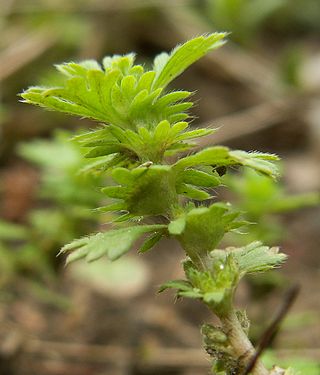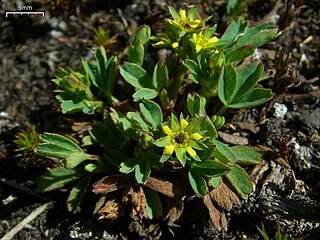
Rosaceae, the rose family, is a medium-sized family of flowering plants that includes 4,828 known species in 91 genera.

Potentilla is a genus containing over 500 species of annual, biennial and perennial herbaceous flowering plants in the rose family, Rosaceae.

Dryas is a genus of perennial cushion-forming evergreen dwarf shrubs in the family Rosaceae, native to the arctic and alpine regions of Europe, Asia and North America. The genus is named after the dryads, the tree nymphs of ancient Greek mythology. The classification of Dryas within the Rosaceae has been unclear. The genus was formerly placed in the subfamily Rosoideae, but is now placed in subfamily Dryadoideae.

Aphanes (parsley-piert) is a genus of around 20 species in the rose family (Rosaceae), native to Europe, Asia and Australia. A 2003 study indicated that Aphanes may belong to the genus Alchemilla, commonly called lady's-mantle. They are slender, annual prostrate herbs, much-branched with deeply lobed leaves, pilose and on short petioles. The tiny green to yellow flowers without petals grow in clusters in the denticulate leaflike stipules.

Cercocarpus, commonly known as mountain mahogany, is a small genus of at least nine species of nitrogen-fixing flowering plants in the rose family, Rosaceae. They are native to the western United States and northern Mexico, where they grow in chaparral and semidesert habitats and climates, often at high altitudes. Several are found in the California chaparral and woodlands ecoregion.

Dasiphora is a genus of shrubs in the rose family Rosaceae, native to Asia, with one species D. fruticosa, ranging across the entire cool temperate Northern Hemisphere. In the past, the genus was normally included in Potentilla as Potentilla sect. Rhopalostylae, but genetic evidence has shown it to be distinct.

Potentilla indica, known commonly as mock strawberry, Indian-strawberry, or false strawberry, often referred to as a backyard strawberry, mainly in North America, is a flowering plant in the family Rosaceae. It has foliage and an aggregate accessory fruit similar to that of a true strawberry. It has yellow flowers, unlike the white or slightly pink flowers of true strawberries. It is native to eastern and southern Asia, but has been introduced to many other areas as a medicinal and an ornamental plant, subsequently naturalizing in many regions worldwide. It is considered invasive in some regions of the United States.

Purshia is a small genus of 5–8 species of flowering plants in the family Rosaceae which are native to western North America.

Sanguisorbinae is a subtribe of flowering plants in the rose family, Rosaceae. It is the sister to subtribe Agrimoniinae in tribe Sanguisorbeae.

Sanguisorba officinalis, commonly known as great burnet, is a plant in the family Rosaceae, subfamily Rosoideae. It is native throughout the cooler regions of the Northern Hemisphere in Europe, northern Asia, and northern North America.

Sibbaldia tridentata is a species in the plant family Rosaceae. Its synonyms include the illegitimate name Sibbaldia retusa and Sibbaldiopsis tridentata. Under the latter name, it has been treated as the only species in the genus Sibbaldiopsis. Its English names include three-toothed cinquefoil, shrubby fivefingers, and wineleaf.

Comarum is a genus of plants formerly included with the genus Potentilla. It contains one or two species:

Drymocallis is a genus of plants formerly included with the typical cinquefoils (Potentilla). It contains three species known or suspected to be protocarnivorous, but more cinquefoils might eventually be moved here:

Sieversia is a genus of flowering plants of the family Rosaceae. It is also in the subfamily Rosoideae, and tribe Colurieae.

Potentilleae is a tribe of the rose family, Rosaceae.

Sibbaldia is a genus of flowering plants of the family Rosaceae, with a circumpolar distribution, including the high Arctic. The type species is Sibbaldia procumbens. It is also in the Rosoideae subfamily.

Dasiphora fruticosa var. veitchii is a flowering plant in the family Rosaceae, native to Sichuan and Yunnan in China. It was first described as the species Potentilla veitchii by Ernest Henry Wilson in 1911, after he had earlier introduced it into gardens in the United Kingdom. Its scientific name and status have varied, and remained "unresolved" according to the Royal Horticultural Society as of May 2022. In horticulture, it may also be found under the names Potentilla davurica var. veitchii and Potentilla fruticosa var. veitchii. It is cultivated as an ornamental flowering shrub.

















